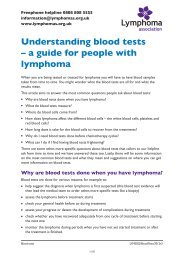Cutaneous T-cell lymphoma - Lymphoma Association
Cutaneous T-cell lymphoma - Lymphoma Association
Cutaneous T-cell lymphoma - Lymphoma Association
You also want an ePaper? Increase the reach of your titles
YUMPU automatically turns print PDFs into web optimized ePapers that Google loves.
What do the tests tell the medical team?The appearance of your skin, together with the physical examination and all the testresults will usually provide:● a diagnosis of what type of skin <strong>lymphoma</strong> you have – whether it is a T-<strong>cell</strong> or aB-<strong>cell</strong> skin <strong>lymphoma</strong>, for example, and exactly which one● information on how the <strong>lymphoma</strong> is behaving – whether it is slow growing(low grade or 'indolent') or faster growing (high grade)● an indication of how much the <strong>lymphoma</strong> is affecting the body – the ‘stage’ of the<strong>lymphoma</strong>.It is important to know the type, grade and stage of a <strong>lymphoma</strong> so that the doctorswill have an idea of how it might behave in future and of how best to treat you.What do ‘low grade’ and ‘high grade’ mean?The skin biopsy will help the specialist to know how fast the lymphocytes are dividingand multiplying. Slow-growing <strong>lymphoma</strong>s are described as ‘low grade’ and fastergrowing <strong>lymphoma</strong>s as ‘high grade’. Most skin <strong>lymphoma</strong>s are slow growing. Thetable below divides the different types of CTCL into those that are slow growing andthose that develop and grow more rapidly. How fast the <strong>lymphoma</strong> is developing willbe an important factor in deciding which treatments would be most suitable and howsoon the treatment should be started.Slow-growing types of CTCL● Classic mycosis fungoides● Rarer types of mycosis fungoides:– folliculotropic mycosis fungoides– pagetoid reticulosis– granulomatous slack skin● Primary cutaneous CD30-positivelymphoproliferative disorders:●– primary cutaneous anaplasticlarge-<strong>cell</strong> <strong>lymphoma</strong>– <strong>lymphoma</strong>toid papulosisSubcutaneous panniculitis-like T-<strong>cell</strong><strong>lymphoma</strong>● Primary cutaneous CD4-positivesmall/medium T-<strong>cell</strong> <strong>lymphoma</strong>Faster growing types of CTCL● Sézary syndrome● Adult T-<strong>cell</strong> leukaemia/<strong>lymphoma</strong>● Extranodal NK/T-<strong>cell</strong> <strong>lymphoma</strong>, nasaltype● Primary cutaneous peripheral T-<strong>cell</strong><strong>lymphoma</strong>, unspecified● Primary cutaneous CD8-positiveaggressive epidermitropic cytotoxicT-<strong>cell</strong> <strong>lymphoma</strong>● Primary cutaneous gamma/delta T-<strong>cell</strong><strong>lymphoma</strong>You will find information about the different types of CTCL on pages 10–14.<strong>Cutaneous</strong> T-<strong>cell</strong> <strong>lymphoma</strong>LYM0157/CTCL/2013v37/18












